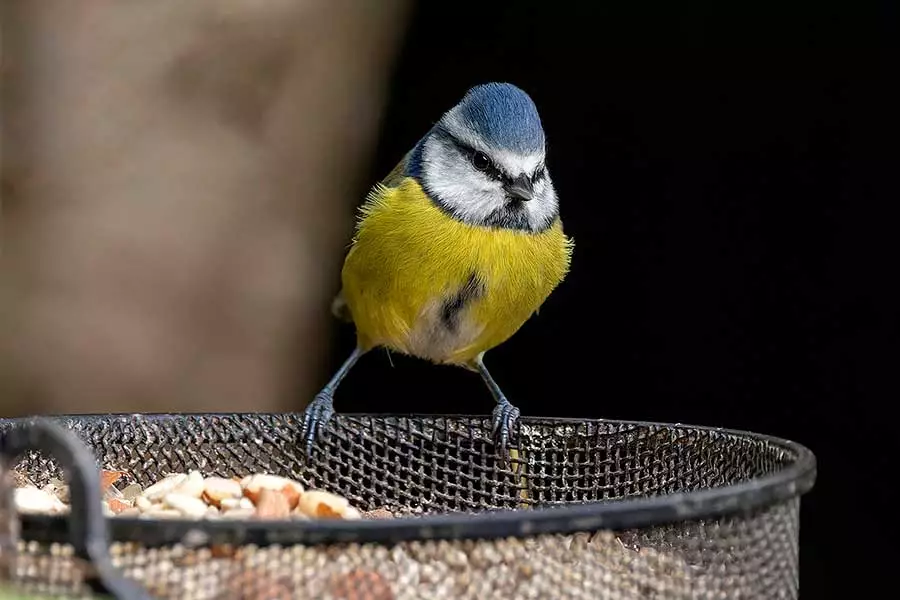DIY Video Studio is supported by its readers who use the affiliate links or ads on this site. As an Amazon Associate, I earn from qualifying purchases. Thank your support if you use any of the links.
Although features provided by your camera body are important for photography, it’s the quality of your lens that will determine how good your images appear. So, what lens is best for bird photography and why?
Lenses with focal lengths of 400mm to 800mm and apertures around f/4 or 5.6 are favoured by bird and wildlife photographers, who will often add a 1.4x or 2x extender for additional reach. Prime and zoom lenses each have their own advantages, but beginners usually start with a zoom because of its versatility.
What focal length do you need for backyard bird photography?
From personal experience, you need as much focal length as possible. You will sometimes find yourself in a situation where a little more reach is necessary. But when you factor in your budget and what lenses are available, “as much as possible”, realistically becomes 600 – 800mm. With a 2x extender (also known as a teleconverter), that effectively becomes 1200 – 1600mm. However, that will push the image quality a little. Even outside factors like heat haze will become even more apparent at those kinds of focal lengths. You’ll probably get better results by trying to get closer to the subject and using a focal length in the 400-1000mm range.
When taking shots of single birds most bird photographers aim to have the bird fill about a third of the frame height. Although the subject, situation, your personal preference, and choice of composition will also determine the size of the bird in the frame. Obviously, you will need less focal length to fill the frame when photographing a Crow than a House Sparrow, so your choice of focal length will also be determined by the species you’re targeting.
The following image sequence shows how large a bird appears in the frame at focal lengths from 100 to 700mm using a Canon RF 100-500mm f/4.5-7.1 at f/10 (+1.4x extender for 700mm). The distance to the toy bird is 30ft (9.15m).
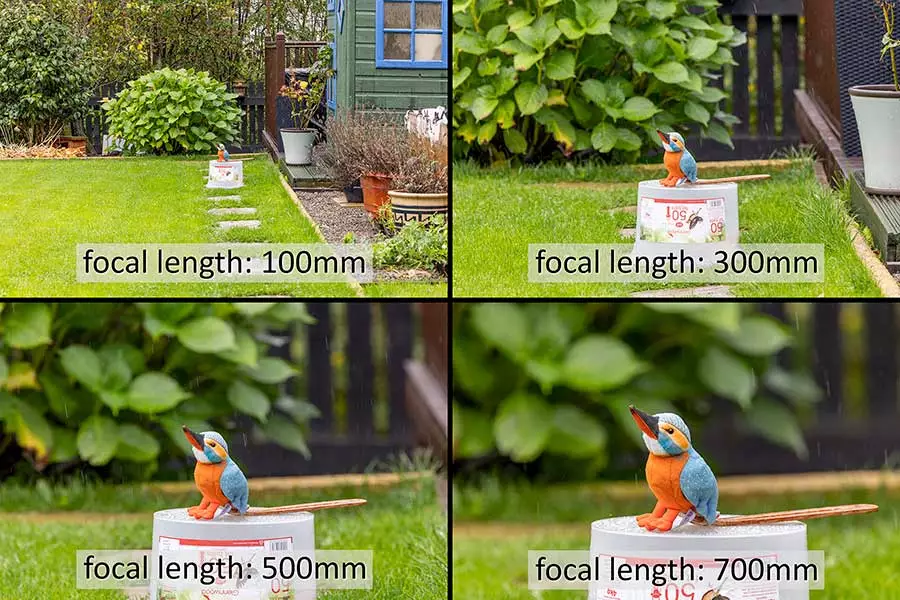
In these images I’ve used a soft toy bird to simulate the size of a typical backyard or garden bird. For reference, the bird is about 6 inches high, so a reasonable substitute for a bird like a Blackbird or Starling. Obviously, birds the size of a sparrow will look about half the size.
In these images you can see that increasing the focal length makes a big difference to the size of the bird in the frame.
At 30ft, a focal length of 300mm would be good for a small group of birds. Shots of individual birds would work using a focal length of 400 – 500mm. And at a focal length of 700mm you’ll be able to show good detail.
The super telephoto lens I used for these images has a maximum focal length of 500mm, so with a 2x extender the maximum focal length would have been 1000mm. At that focal length, and a distance of 30ft, you’ll be able to fill the frame with your subject.
Can you only get good background blur with fast lenses?
In the images taken at different focal lengths you may have noticed something other than the changing size of the bird. Even though every image was shot at an aperture of f/10 the background blur is not the same in each image but changes with focal length.
Even when the lens aperture remains constant, the depth of field decreases as the focal length increases. So, the background becomes blurrier as you move to longer focal lengths. The background will also become blurrier as you get closer to the subject and/or the background is further behind the subject.
That’s why I photograph small backyard birds, such as Tits, at a distance of only 14ft in my backyard. When I get so close to the birds, the depth of field is quite shallow and the background becomes blurred. That’s possible because Blue Tits, Great Tits, Coal Tits, Siskins, and Robins are relatively tame. I don’t even use a blind or any camouflage. I’ll sit on a garden seat and although the birds are aware of me, my presence doesn’t seem to bother them.
The following image of a Coal Tit feeding was taken with my Canon R6 and Canon RF100-500mm F4.5-7.1 L IS USM zoom telephoto at a focal length of 500mm, f/7.1, and ISO 16,000. The distance to the feeder was just 14ft, and even though the background was just a few feet further away, the background is blurred despite the relatively slow aperture.
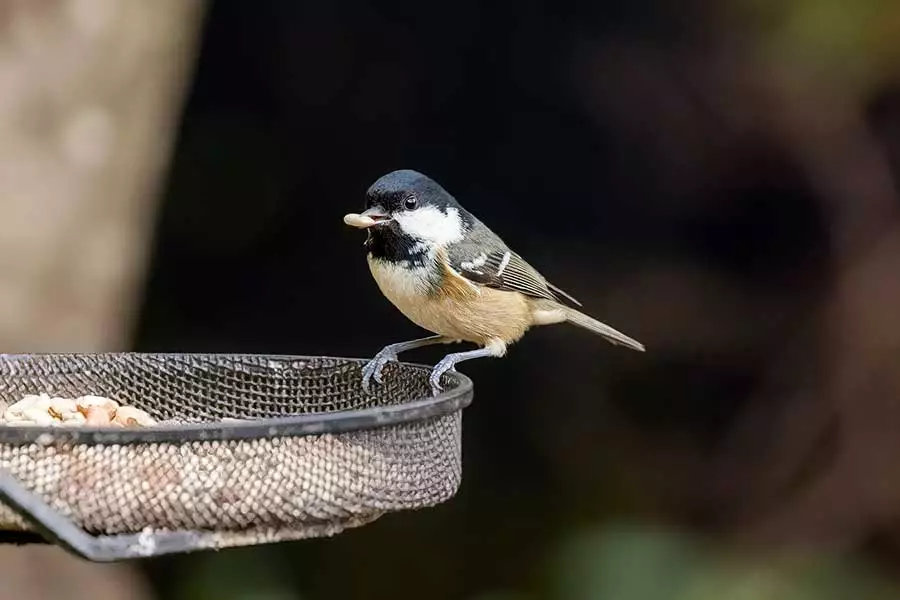
If you have a camera that can handle shooting in low light, such as the Canon R5 and R6, and you can get close to the bird, don’t worry too much about using a slow aperture and high ISO. You can still get blurry backgrounds and clean looking images, as you can see in my image of a Coal Tit.
Remember to check the minimum focusing distance (MFD) of the lens
Not all telephoto lenses let you get close to your subject. I have two zoom telephoto lenses, the Canon RF100-500, and Sigma 150-600mm Sport. Both have similar focal length ranges but their minimum focusing distances are very different. With the Canon I can shoot at between 3 – 4ft from the subject, but with the Sigma I need to get back to 8.5ft before the lens will focus.
Eight and a half feet is still not too bad. Canon’s RF 800mm F11 lens has a minimum focusing distances of about 19.5ft.
Why is this important?
If you have a smaller backyard it’s possible you might not be able to get into a position where you can focus on the bird. But even if you’re out enjoying a trek through a forest a long MFD can be a problem. If you suddenly spot a bird perched in a tree just off the path, you might have to back up until your lens is able to focus. A large MFD isn’t a bad thing, you just need to be aware of it if you’re getting too close to the subject.
Will a heavy lens be a pain to carry around all day?
As I mentioned earlier, I have two telephoto lenses. It’s not because I plenty of cash or that I collect lenses. I simply made a mistake in get the Sigma 150-600mm Sport lens. Although I love the images it can take and the 840mm reach with a 1.4x extender, I’m not keen on the weight.
The Sigma Sport lens is made of metal, is built like a tank, and can handle some rough treatment, but I can’t hand hold it for any length of time. Even for the few second that I can hold it up, I’m struggling so much that the shake means most of my shots are blurred. For me, this awesome lens needs to go on a strong tripod, which is too much weight to carry around for any length of time.
With hindsight, I should have got the much lighter “Contemporary” version of the lens and not the heavy “Sport” version. After six months of owning the Sigma, I had to buy the Canon RF100-500mm F4.5-7.1 L IS USM zoom telephoto. Which, as it turned out, was the lens I should have got in the first place.
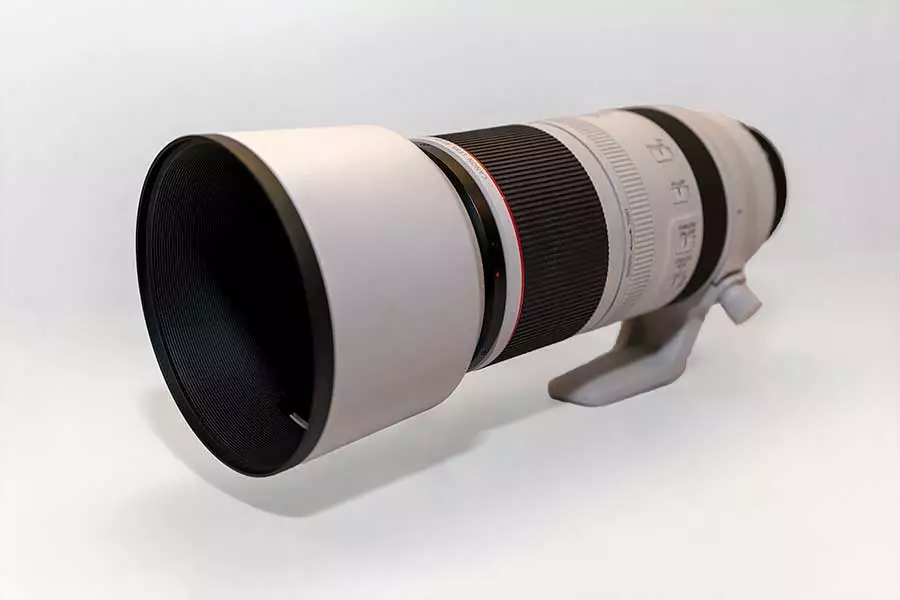
Unless you have muscles like Popeye, a heavy lens will sap your strength and ruin your day taking wildlife shots. The effort of hefting up your gear will introduce unnecessary camera shake and reduce the number of keepers on your memory cards. If you fancy getting one of these heavyweights, I’d advise you to hire one for a day or two to check that it is the right lens for you.
Get more good shots when the lens matches your camera
Weight wasn’t the only reason I changed from my Sigma to a Canon lens. I learned another important lesson. Some lenses work better with certain cameras. More correctly, cameras are better at communicating with native lenses, i.e. lenses from the company that made the camera.
My experience is that Canon lenses work so much better on Canon camera bodies. The RF100-500mm lens is designed to work with cameras using Canon’s RF mount, while the Sigma had to be adapted to my Canon R6. I find that the Canon lens is sharper, autofocus is faster, and it is better at staying locked on to the subject. With the Sigma I had real problems getting shots of flying birds but with the Canon RF lens I find it a whole lot easier to do.
But it’s not about adapting the lens that caused the reduction in performance because I have used Canon’s EF mount lenses adapted onto my Canon R and R6. In all cases I have not experienced any issues.
I suspect you get the best results when you fit a Canon lens on a Canon camera body, with the same being true for Nikon and Sony. Which makes sense, they know best how their technology works.
So why would you buy a third-party telephoto lens? Quite simply, price. As an example (an extreme example I admit), the Canon RF100-500 F4.5-7.1 L IS USM is about three times the cost of the Sigma 150-600 F5-6.3 DG OS HSM Contemporary lens. If cost is an important buying consideration, then a third-party lens is a great option or even a lower spec lens from the manufacturer of your camera body. The performance will still be very good and may even exceed your expectations.
You can get more reach by adding an extender to your telephoto lens
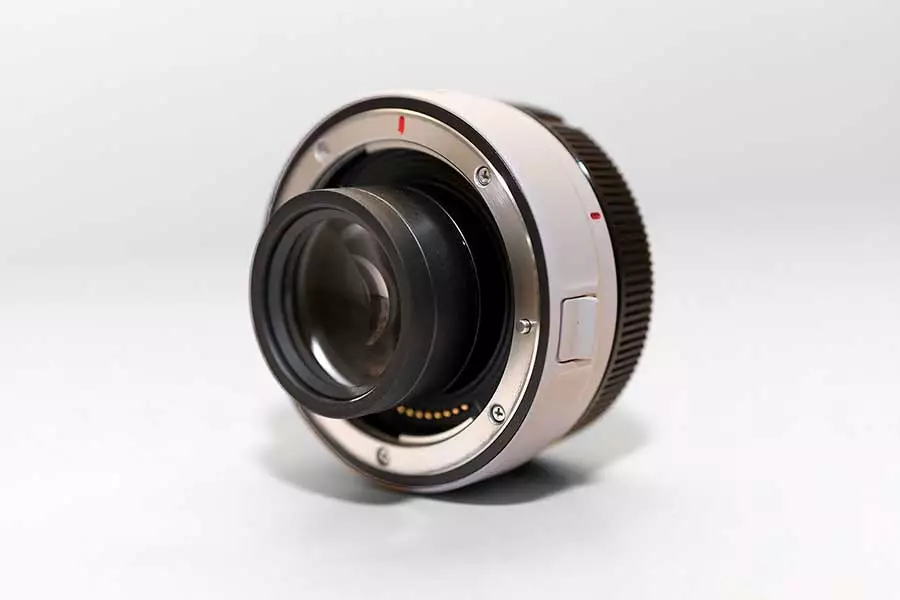
To get even more reach with your telephoto lens you can use an extender, also known as a teleconverter. Ones from Canon, Sony, and Nikon are not cheap but, as you might expect, are very good quality. Depending on the manufacturer, you can get 1.4x, 1.7x, and 2.0x teleconverters. These will increase the focal length by the stated factor but there is a cost, other than financial. You will lose one to two stops of exposure, depending on which extender you use, and there may be some image degradation as well.
If all you want more reach but are less critical about image quality, then a cheap teleconverter might be ideal. You’ll find options from companies like Kenko, Vivitar, and some lesser-known brands on online stores.
15 affordable telephoto lenses for bird photography
Although I’ve mentioned the two telephoto zoom lenses I own, there are many others you could choose for backyard bird photography.
Since I assume you want to capture good quality images, most of the lenses in this comparison chart are high quality. For instance, I’ve listed a few Canon L series lenes that are often faster, and weather sealed, both welcome features since not all locations are always bright and sunny. Even so, I have also included some more affordable lenses that are not all-weather glass.
Since this is a list of what I would consider affordable lenses for serious bird photographers, I have left out many lenses that only professionals would buy. For example, the average birder will not buy the Canon EF 500mm f/4L IS II USM at $8,999, nor the Canon EF 800mm f/5.6L IS USM at $12,999.
With the exception of the Canon EF400mm F5.6 L, all the other lenses in this list have Image Stabalization (IS), or in the case of the Nikon lenses, Vibration Reduction (VR).
| LENS | FOCAL LENGTH | APERTURE | MFD | WEIGHT |
|---|---|---|---|---|
| Canon EF 300mm F4L IS USM | 300mm | 4 | 1.5m/4.9ft | 1.2kg/2.6lb |
| Canon EF400mm F5.6 L | 400mm | 5.6 | 3.5m/11.5 ft | 1.3kg/2.8lb |
| Canon EF 100-400mm F4.5-5.6L IS II USM | 100-400mm | 4.5-5.6 | 1.0m/3.2ft | 1.6kg/3.6lb |
| Canon RF100-400mm F5.6-8 IS USM | 100-400mm | 5.6-8 | 1.2-1.1m/3.9-3.4ft | 0.6kg/1.4lb |
| Canon RF600mm F11 IS STM | 600mm | 11 | 4.5m/14.8ft | 0.9kg/2.1lb |
| Canon RF800mm F11 IS STM | 800mm | 11 | 6.0m/19.7ft | 1.3kg/2.8lb |
| Canon RF100-500mm F4.5-7.1 L IS USM | 500mm | 4.5-7.1 | 0.9m-1.2m/3.0-3.9ft | 1.5kg/3.4lb |
| Nikon AF-S NIKKOR 200-500mm F5.6E ED VR | 200-500mm | 5.6 | 2.2m/7.2 ft | 2.3kg/5.0lb |
| Nikon AF-S NIKKOR 500mm F5.6E PF ED VR | 500mm | 5.6 | 3.0m/9.8ft | 1.5kg/3.2lb |
| Sigma 60-600mm F4.5-6.3 DG OS HSM Sport | 60-600mm | 4.5-6.3 | 0.6-2.6m/2-8.5ft | 2.7kg/6.0lb |
| Sigma 150-600mm F5-6.3 DG OS HSM Contemp | 150-600mm | 5-6.3 | 2.8m/9.2ft | 1.9kg/4.3lb |
| Sigma 150-600mm F5-6.3 DG OS HSM Sport | 150-600mm | 5-6.3 | 2.6m/8.5ft | 2.9kg/6.3lb |
| Sony FE 200-600mm F5.6-6.3 G OSS | 200-600mm | 5.6-6.3 | 2.4m/7.9ft | 2.1kg/4.7lb |
| Tamron SP 150-600 F5-6.3 Di VC USD G2 | 150-600mm | 5-6.3 | 2.2m/7.2ft | 2.0kg/4.4lb |
| Tamron 150-500mm F5-6.7 Di III VC VXD | 150-500mm | 5-6.7 | 0.6m-1.8m/2-5.9ft | 1.9kg/4.1lb |
If you are interested in buying a super telephoto lens I have included links below to several available on Amzon. If you use these links I may earn a commision but you do not pay any extra. Thank you if you do make a purchase. If you are new to bird photography and would like to give it a try inexpensively before commiting to spending several hundred dollars or more on a lens, scroll down to the next section on using a cheap vintage lens.









Last update on 2025-07-06 / Affiliate links / Images from Amazon Product Advertising API
Table could not be displayed.Consider a vintage lens as a cheap way to start bird photography
Assuming you are just starting in bird photography, investing in high quality telephoto prime or zoom lenses may be a financial challenge. If you want to try this fascinating area of photography while keeping the cost to an absolute minimum, why not get an inexpensive vintage lens and adapt it to your modern camera body.
With bird photography focal length is king, and in most cases, the longer the focal length the better. Although I would normally recommend getting a lens with a focal length of between 400 and 600mm, an old 210mm lens can help get you started, or at least let you know whether bird photography is for you.
One option to consider is a vintage Vivitar 70-210mm lens. These can be picked up very cheaply on eBay, and some models are quite good optically, considering they date from around the 1970s. The downside is that they are fully manual. So focus and exposure are controlled by turning the appropriate ring on the lens tube.
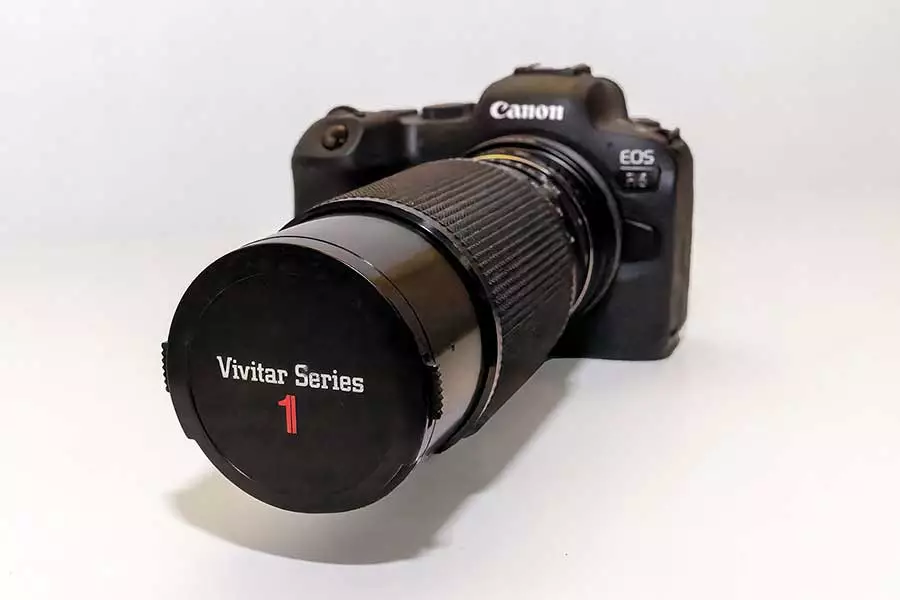
Even so, bird photography with one of these vintage lenses is certainly possible. I inherited a 40+ year old Vivitar Series 1 70-210mm lens a few years back. It has an Olympus OM mount, so I bought an inexpensive OM-EOS R adapter to mount the lens on my Canon EOS R.
Forget any idea of having autofocus or tracking. This baby is all manual. Pre-focus on a perch or feeder where you expect the bird to land, set the aperture to between f/5.6 and f/11, and wait. Many of your shots will be imperfect, but some will be keepers.
As an example, here is a shot of a Dunnock I took with a Vivitar 70-210mm lens on a Canon EOS R camera body. After some light post processing I was surprised at the image quality, conosidering I was using a lens that must have been over 40 years old.
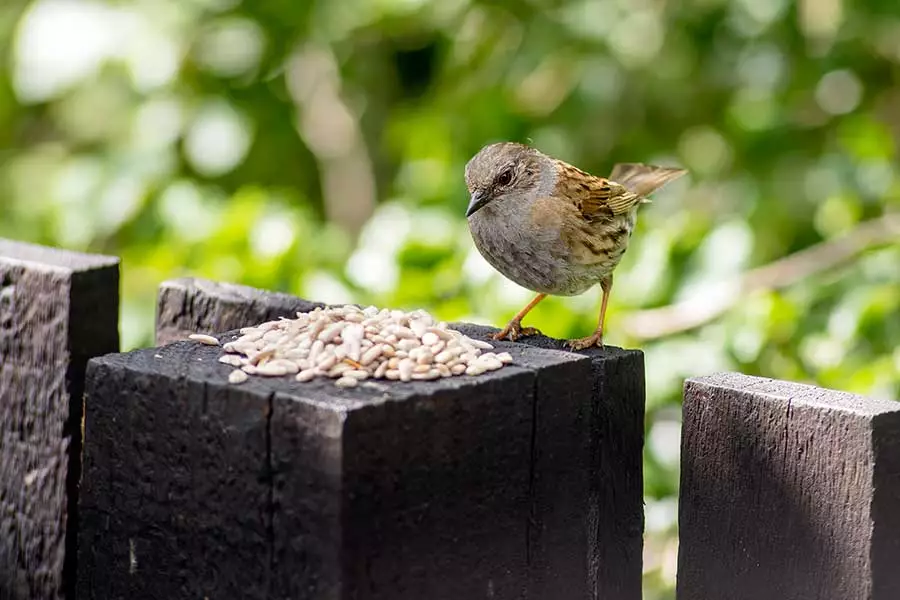
To show the image of the Dunnock wasn’t a lucky shot, here’s another one of a juvenile Blue Tit taken with the Vivitar lens.
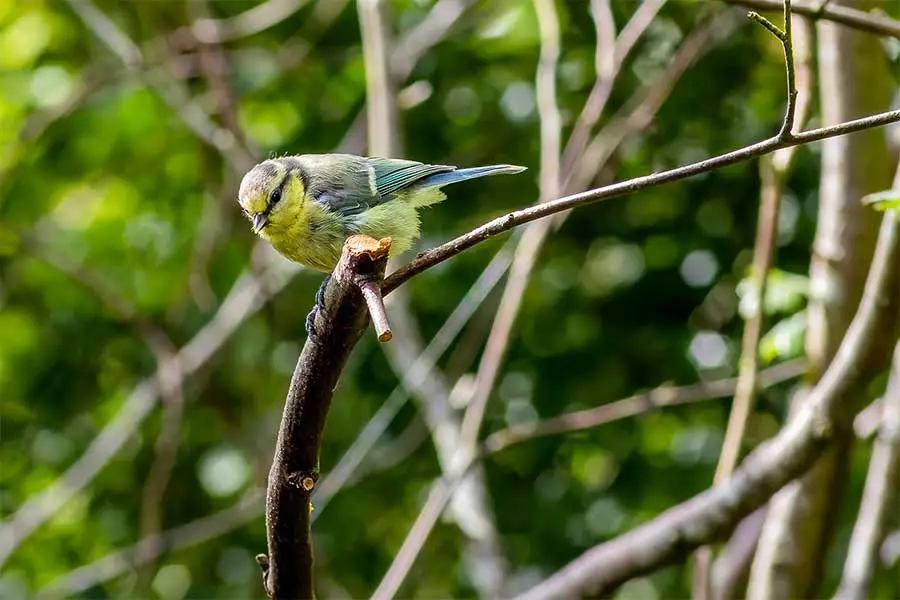
Although the Vivitar is a true vintage lens, you could also look at more modern pre-owned lenses. The Canon EF 400mm F5.6L lens, although listed on Canon’s website does not seem to be available as a brand new lens. The price used to be around $1,200. Good used examples of this lens can be bought for under $900. Autofocus and exposure control will work as normal, but you won’t have the luxury of built-in image stabalization. Even so, this is a good Canon EF-mount lens.
Summary
The lens is the heart of your photography system. If your budget is limited, spend as much as you can on a good quality lens, even if it is refurnished or used. Spend the rest of your budget on a camera body, with the intention of upgrading later when funds are available.
If you’re still saving to get your first camera and lens, consider using your smartphone, but upgrade the camera app so you have manual control.
If you’ve already got the money and are set to buy your photography gear, get the best you can afford, especially the lens.
You may also like…
- Minimum Focusing Distance of Sigma 150-600 with Extension Tubes – Enough for Macro?
- Backyard Bird Photography Setup and Equipment for Beginners
- More Telephoto Lens Magnification with Macro Extension Tubes
- What is the best camera for backyard bird photography?
- Using Canon Custom White Balance Settings on EOS R / R5 / R6
- How to Safely Clean a Camera Lens with Alcohol
- How To Get Rid of Camera Lens Fungus & Prevent It from Coming Back
Tosh Lubek runs an audio and video production business in the UK and has been using the Canon EOS R since it was released in the Autumn of 2018 and the Canon EOS R6 in 2020. He has used both cameras to shoot TV commercials broadcast on Sky TV, promotional business videos, videos of events and functions, and YouTube creator content. He has also won several international awards for his advertising and promotional work. You can meet him by visiting his “video booth” at HashTag Business Events across the country.
Recent Posts
You're Using the Canon RF 50mm f/1.8 WRONG! Here’s How to Fix It
If you’ve recently picked up the Canon RF 50mm f/1.8 STM—affectionately known as the Nifty Fifty—you might be confused by that strange switch on the side of the lens. It doesn’t say AF/MF...
Recently, I shot several customer testimonial videos in 4K for a client when the overheating warning on my Canon EOS R6 appeared. In fact, it appeared three times in five sessions during the day of...


